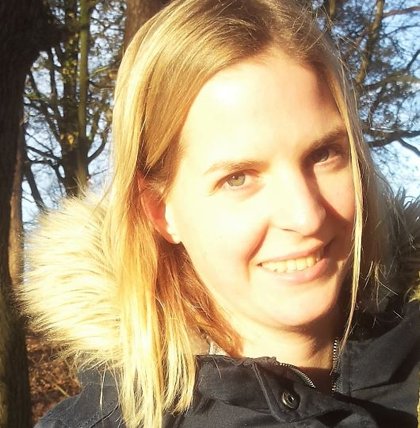Bicycling stability - simulations & experiments to improve cycling safety for older cyclists
Vera Bulsink is a PhD Student from the department Biomedical Engineering. Her supervisor is professor Bart Koopman from the engineering technology faculty.

Cycling is a healthy and popular means of transportation. When over 55 years, cyclists encounter an increased accident risk and develop difficulties in balancing and controlling their bicycle. They establish a fear of falling and eventually will stop cycling at all. To maintain their quality of life, they would need to keep cycling for as long as possible. Development of safer bicycles for older cyclists, that assist in balance control are therefor needed.
This thesis studies bicycle dynamics and bicycling stability of older cyclists with the use of computer model simulations and a laboratory cycling set-up.
An advanced bicycle-cyclist model is developed in the commercial software ADAMS. The model includes dynamics of the bicycle itself, a tire-road contact model, a passive biomechanical model of the cyclist and a cyclist balance control model. The tire-road contact model was based on experiments with four different tires at several working conditions. With this dataset, the coefficients of the Magic Formula of Pacejka were derived and a load-dependent tire-road contact model was developed.
An open-loop bicycle-cyclist model was used to test the influence of tire and cyclist properties on bicycle stability. It was shown that extending bicycle dynamical models with a realistic tire model leads to a notable decrease of the weave stability and a stabilization of the capsize mode. This effect is mainly caused by the twisting torque. Tire properties and passive cyclist properties interacted with each other, therefore it is important to incorporate both in the model.
A novel laboratory cycling set-up was developed, in order to (1) test differences in cycling strategies of young and older cyclist, (2) validate bicycle-cyclist models, (3) identify a cyclist control model. On the cycling set-up, it was possible to apply controlled lateral perturbations to the bicycle-cyclist system in a safe environment. Thirty (fifteen young and fifteen older) participants took part in the cycling experiments at different cycling speeds, while the kinematics of the bicycle and cyclist were measured, together with the bicycle-cyclist interaction forces. This resulted in a unique dataset.
Three possible cycling control strategies of older cyclists were compared to that of younger cyclists: steering, lateral upper-body movements and outward knee movements. The older cyclists tend to rely more on outward knee movement as a secondary control mechanism (next to steering) than the younger subject group. Increased inter-individual variation for the older cyclist group suggests that this group can be seen as a transition group in terms of physical fitness.
The measured bicycle-cyclist interaction forces and kinematics were used to validate a bicycle-cyclist interaction model. Resultant forces of 8-19% of the maximum force magnitude were found toto ensure dynamic consistency of the model. These resultant forces can be related to inaccuracies of the experimental data and modelling assumptions. Accurately measuring the pedal forces and increased subject-specific modelling could increase the validity of the model.
A SIMO (single-input-multiple-output) cyclist balance control model for young and older cyclists was identified from the cycling dataset. It was found that the steering and upper-body lean control can be modelled with a PD controller with time delay, whereas the outward knee control was limited to low frequencies. The results suggest that the knee control and upper body lean control are reflex-like, while the steering control uses visual feedback loops. Older subjects needed more time to react than the younger cyclists. The older cyclists also seem to revert to more additional control mechanisms (next to the main control: steering) at a higher speed than younger cyclists. At low speeds, the older subjects had difficulties cycling on the rather tight treadmill. This could be explained by the increased time delay of older cyclists, together with the higher control gains that are needed when cycling at low speeds. These results imply that older cyclists could benefit from an improvement of the bicycle’s stability at low speeds. In that case they need less additional control actions and lower gains.
Computer simulations were used to test several solutions to increase the bicycle at low speeds. One of these solutions was the ‘two-motor’ system that lowers the weave speed. These simulations also resulted in an optimized geometry that was used in the ‘SOFIETS’, the bicycle that was developed in the project SOFIE (Slimme Ondersteunde FIEts/Smart Assistive Bicycle).
